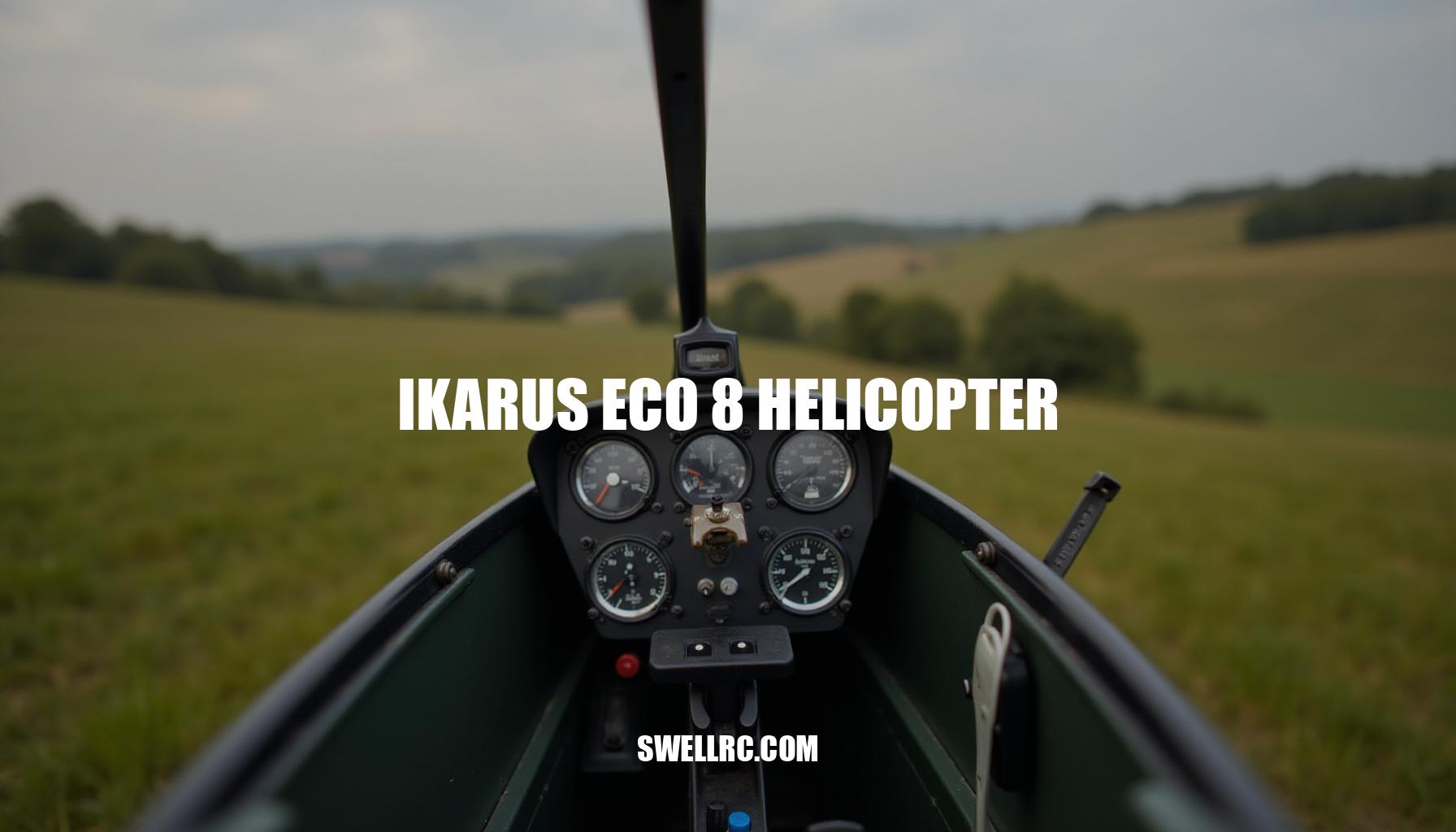Ikarus Eco 8 Helicopter Review: A Classic RC Model’s Enduring Legacy
I recently rediscovered my Ikarus Eco 8, a timeless gem among RC helicopter kits, buried beneath newer acquisitions. This electric-powered RC helicopter carries the wear marks and fond memories of early electric collective-pitch flying. Its first spool-up after years in storage reminded me why it earned a legendary status: quietly efficient and remarkably capable for its time.
Long before today’s advanced brushless motors and FBL-stabilized micros, the Eco 8 demonstrated that remote control aircraft could be both practical and exhilarating. Revisiting this classic Ikarus model offers more than nostalgia—it’s an opportunity to appreciate the evolution of our hobby and gain valuable insights into model helicopter assembly, precise setup, balance, and disciplined flight. Although modern micro helicopters like the Esky 150 V3 and the flybarless Eachine E160 showcase cutting-edge technology, the Eco 8 feels mechanical and heartfelt—an analog classroom for any RC pilot eager to master the basics and enjoy honest, stable flight.
History & Evolution — Where the Ikarus Eco 8 Fits in the RC Helicopter World
Ikarus approached electric flight with a practical engineer’s mindset: keep mass low, simplify service, and make the airframe modular so pilots can learn and upgrade over time. The Eco series embodied that vision. The Eco 8 popularized a mid‑size, electric collective‑pitch layout at a time when NiCd/NiMH packs and brushed motors dominated, yet it still delivered credible flight times and training‑friendly stability.
Its composite/plastic frame, belt‑driven tail, and flybarred head became a template for countless garage upgrades. This design philosophy has left a lasting imprint on the world of electric scale helicopters, and the eco helicopter legacy is readily apparent in many contemporary models.
Today, when you hold a micro CP like the XK K110S helicopter, you can feel the lineage—lighter materials, FBL brains, and powerful LiPos—but the DNA of accessible electric flight traces right back to pioneers like the Eco 8. Looking back through RC helicopter history and advancements in flight simulation, it’s evident how the Ikarus models shaped modern flight control approaches.
| Feature | Eco 8 (Ikarus) | XK K110S | Blade 230 S V2 |
|---|---|---|---|
| Era | Early 2000s | 2020s | 2020s |
| Main Rotor Span (approx.) |
480 mm | 270 mm | 520 mm |
| Power System (cells/chemistry) |
7-cell NiMH | 2S LiPo | 3S LiPo |
| Average Flight Time | 7-10 min | 8-10 min | 7-12 min |
| Control System | Flybar | Flybarless (FBL) | Flybarless (FBL) |
| Price Segment | Entry to Mid-range | Budget | Mid to High-end |
The comparison clearly illustrates how the Ikarus models like the Eco 8 laid down the foundation for today’s diverse and feature-rich micro and mid-size collective pitch electric helicopters. Their commitment to modular design and flight accessibility persists, inspiring pilots and engineers alike in this ongoing evolution of electric flight.
Technical Overview — Inside the Ikarus Eco 8 Design
The Eco 8 electric-powered RC helicopter stands out for its modular design and transparency, allowing pilots to see and feel how every subsystem works. The composite side-frame and plate layout keeps the weight reasonable while providing ample room to swap components, making it a favorite among enthusiasts who enjoy customizing their setups. Its flybarred head with collective pitch delivers a predictable and teachable collective pitch setup, providing invaluable hands-on experience in understanding helicopter mechanics from first principles.
The belt-driven tail system favors durability and simplifies tensioning, a design well appreciated in the realm of RC helicopter kits. Originally, the Eco 8 ran on brushed motors and NiCd/NiMH packs, but most surviving units have been upgraded to brushless motors and LiPo battery conversions for enhanced performance and efficiency. A simple rate gyro was typical in its initial build; however, modern owners often retrofit flybarless (FBL) control units, gaining superior gyro stabilization, improved tail authority, and integrated governor control which boosts flight precision and responsiveness.
For those exploring design evolution within electric RC helicopters, comparing the Eco 8 with models like the Eachine E200 (noted for its modern FBL packaging) or the Hero RC H911 (which features compact, trainer-friendly control systems) offers valuable insight.
| Specification | Details |
|---|---|
| Frame Material | Composite side-frame and plate layout |
| Main Rotor Diameter | Approximately 450–460 mm (varies by blade type) |
| Tail Drive Type | Belt-driven tail for durability and easy tensioning |
| Head Type | Flybarred collective pitch (CP) head |
| Recommended Motor Class | Brushless motors (commonly retrofitted) |
| Battery Recommendation | 3S–4S LiPo conversions |
| Typical AUW (All Up Weight) | Approx. 360–450 grams (varies with setup) |
| Gyro / FBL Options | Simple rate gyro initially; popular upgrades include flybarless (FBL) control units for enhanced stabilization and tail control |
In summary, the Eco 8’s modular design supports easy motor swaps, adaptable battery trays, serviceable tail mechanics, and a head that provides a true collective pitch setup experience. Its design philosophy and upgrade potential continue to engage pilots seeking a transparent and educational flying platform within the electric-powered RC helicopter universe.
Flight Experience — Putting the Ikarus Eco 8 to the Test
When embarking on a beginner guide for building RC helicopters, meticulous setup begins right on the bench: square the frame, match blade grips, level the swash, and center linkages. Balance is everything—place the pack to meet the center of gravity (CG), then verify pitch range along with throttle and pitch curves. This collective pitch setup ensures optimal control and responsiveness, crucial for mastering remote control aircraft.
The Eco 8’s flight performance review reveals an unmistakable airborne character: a soft, efficient whirr underscored by a flybar’s signature damping effect. It maintains steady tracking in forward flight, handles wind more effectively than typical micros, and encourages smooth circuits, stall turns, and gentle figure eights.
In comparison, a modern, stabilized lightweight like the Eachine E120 helicopter feels more autopiloted, while a basic 3-channel such as the Double Horse 9101 exists in a different universe. The Eco 8 delivers true collective pitch, robust tail authority, and aerobatic headroom when properly tuned.
- Pros:
- Honest, instructive handling that guides pilot learning
- Modular design, making it easy to wrench and upgrade
- Stable trainer ideal for mastering collective pitch fundamentals
- Pleasant acoustic footprint that enhances flying enjoyment
- Cons:
- Out of production, which means parts sourcing can be a challenge
- Flybar mechanism introduces extra mechanical complexity
- Heavier than newer flybarless (FBL) equivalents
- Requires careful initial setup to truly shine in flight
Lessons learned include monitoring tail belt tension vigilantly, avoiding overgearing in brushless motor conversions, and allowing motors to cool adequately between battery packs. With conscientious setup and maintenance, the Eco 8 proves a genuinely rewarding platform for enthusiasts delving into advanced collective pitch setup and remote control aircraft piloting.
Upgrades, Repairs, and Modifications — Breathing New Life into a Classic
When maintaining your Ikarus Eco 8 model helicopter, it’s essential to focus on common refresh points such as main gear wear, tail pulleys and belts, dampers, bearings, and aging link balls to ensure optimal performance and longevity. Popular upgrades and repairs often include installing a mid-KV brushless motor paired with a quality 50–60A ESC and a soft governor for smoother power delivery. Digital metal-gear cyclic servos combined with a fast tail servo enhance responsiveness, while integrating an FBL controller enables advanced gyro stabilization—allowing you to run either flybarless head conversions or maintain the flybar for stabilization purposes.
Modern enthusiasts also incorporate 3D printed RC parts like battery trays, canopy mounts, and cable guides to streamline model helicopter assembly and improve the overall layout. The Eco 8’s frame is particularly accommodating to customization, with some builders drawing inspiration from scale designs like the Yuxiang F09 Black Hawk (link) or adopting full-scale bodies akin to the Vario Robinson R22 RC helicopter (link).
Here’s a comprehensive maintenance checklist to keep your helicopter in peak condition:
- Inspect belt tension and track before each flying session
- Check feathering spindle and dampers every 10–20 flights
- Re-Loctite all critical screws following major services
- Balance blades after any blade or grip changes
- Verify ESC temperatures and gear mesh, especially after power upgrades
When sourcing ikarus eco 8 parts, expect to combine NOS components, 3D-printed substitutes, and compatible bearings or shafts. Leveraging search terms like “ikarus eco 8 parts,” along with active participation on forums such as RCGroups and HeliFreak, plus browsing auction sites, will greatly assist in finding quality components to support your upgrades and repairs.
Alternatives & Comparisons — The Modern Heirs to the Eco 8 Legacy
If you cherish the Eco 8’s ethos of an approachable electric collective pitch (CP) helicopter with upgradable bones, rest assured its spirit thrives in today’s diverse product landscape. From micro CPs delivering budget-friendly practice with powerful FBL (flybarless) controllers, to mid-size sports helis balancing visibility and cost, and finally to electric scale helicopters that capture the romance Eco 8 inspired, the choices abound. This flight performance comparison table highlights selected best electric RC helicopter alternatives across categories:
| Manufacturer / Model | Class / Type | Main Rotor Size | Battery (Cells / Chemistry) | Stabilization | Target Pilot | Typical Price Segment |
|---|---|---|---|---|---|---|
| Blade Nano CP S | Micro CP | 130 mm | 2S LiPo | FBL | Beginner / Intermediate | Low |
| Align T-Rex 250X | Sport | 250 mm | 3S LiPo | Assisted Stabilization | Intermediate | Mid |
| RC Airwolf Black Bell 222 | Scale (1:3.5) | 1100 mm | 12S LiPo | FBL + Gyros | Scale Enthusiasts / Advanced | High |
| Syma S107G | Micro CP (Indoor) | 165 mm | 3.7V Li-ion | Basic Stabilization | Beginner | Low |
| Scorpion HK500GT Pro | Sport | 500 mm | 6S LiPo | FBL | Intermediate / Advanced | Mid-High |
While technical specifications and modern composite construction have leapt ahead since the Eco 8’s debut, its vision of a compact, electric, and upgrade-friendly remote control aircraft remains alive and well in these models. Whether you seek a nimble micro CP for skill-building or the immersive challenge of electric scale helicopters like the RC Airwolf, the legacy endures—fueling countless pilots’ passion for flight today.
Conclusion — Why the Ikarus Eco 8 Still Matters
The Ikarus Eco 8 represents more than just a retired piece from the lineup of Ikarus models; it embodies a masterclass in the fundamentals of rotary flight. This electric-powered RC helicopter has educated a generation on the intricacies of collective pitch mechanics, the importance of tail trimming, and why achieving balance is often more effective than relying solely on brute power. In today’s world dominated by wizard-grade FBL stabilization systems and near-maintenance-free ARFs, the Eco 8 invites enthusiasts to slow down, appreciate the mechanics, and truly enjoy the craft of flying.
For those engaging with the Eco 8, whether wrenching on a vintage model or using it as a beginner guide for building RC helicopters, the lessons remain invaluable. It not only shaped the development of current electric-powered RC helicopter designs but also continues to reward pilots who restore and fly it with a profound understanding of rotary flight principles.
In addition, flight simulation and RC helicopter kits often incorporate learnings from classic models like the Eco 8, helping newcomers gain practical experience before transitioning to actual flight. Whether training on a micro model or planning an ambitious scale build, the overarching message is clear:
- Curiosity drives mastery.
- Careful setup is essential.
- Classics such as the Eco 8 keep the spirit of quality helicopter flight alive.
Frequently Asked Questions
- What is the Ikarus Eco 8 helicopter, and why is it so popular among RC enthusiasts?
The Ikarus Eco 8 is a mid‑size, electric collective‑pitch kit helicopter known for approachable assembly, modular design, and stable training‑friendly flight. It became popular by proving that electric CP could be practical before LiPos and FBL systems, and it remains admired for its teachable mechanics and upgradability. - How does the flight performance of the Ikarus Eco 8 compare to modern RC helicopters?
It flies smoothly and predictably with a flybar’s natural feel, offering solid wind handling for its size. Modern FBL helis are lighter, more efficient, and more locked‑in, but the Eco 8 rewards careful setup with honest, confidence‑building performance—ideal for circuits, hovering practice, and light aerobatics. - What upgrades or modifications can improve the Ikarus Eco 8’s stability and control?
A brushless motor and quality ESC with governor, digital cyclic and tail servos, and an FBL controller (with or without flybar conversion) dramatically improve precision, tail hold, and consistency. Fresh dampers, bearings, and a properly tensioned tail belt also make a noticeable difference. - Is the Ikarus Eco 8 suitable for beginners, or is it more for experienced pilots?
It’s suitable for motivated beginners who want to learn true collective pitch and setup fundamentals, ideally with simulator practice first. Out‑of‑the‑box it’s a builder’s kit, so total newcomers may prefer a modern, stabilized RTF first, then step into the Eco 8 for deeper mechanical learning. - What are the best RC helicopter alternatives to the Ikarus Eco 8?
For easy entry, modern micro CP helis with FBL are excellent. For sport flying, mid‑size FBL kits offer strong visibility and support. For scale passion, large electric scale models deliver the Eco 8’s spirit with today’s electronics. Choose based on desired size, support, and parts availability. - Where can I find replacement parts for the Ikarus Eco 8?
Look for NOS and used parts on auction sites and RC classifieds, search “ikarus eco 8 parts,” and check forums like RCGroups and HeliFreak. Many wear items (bearings, hardware) can be matched generically, and some brackets/canopy mounts can be 3D‑printed or adapted from similar models.



